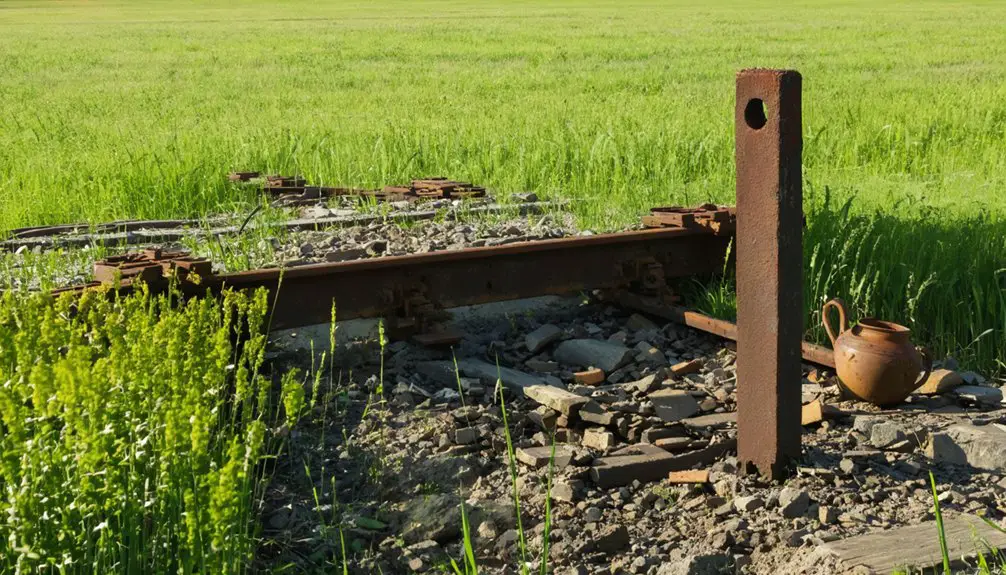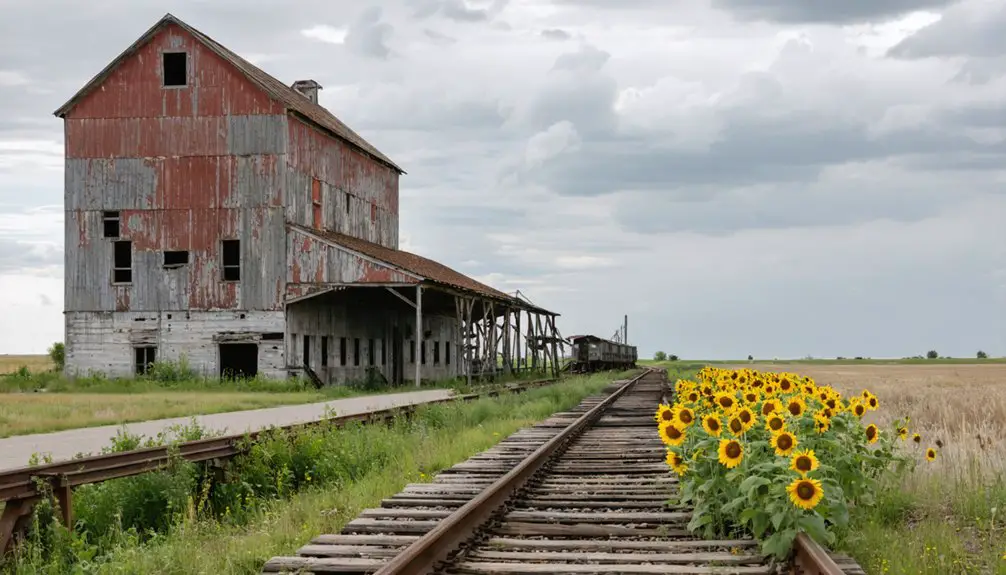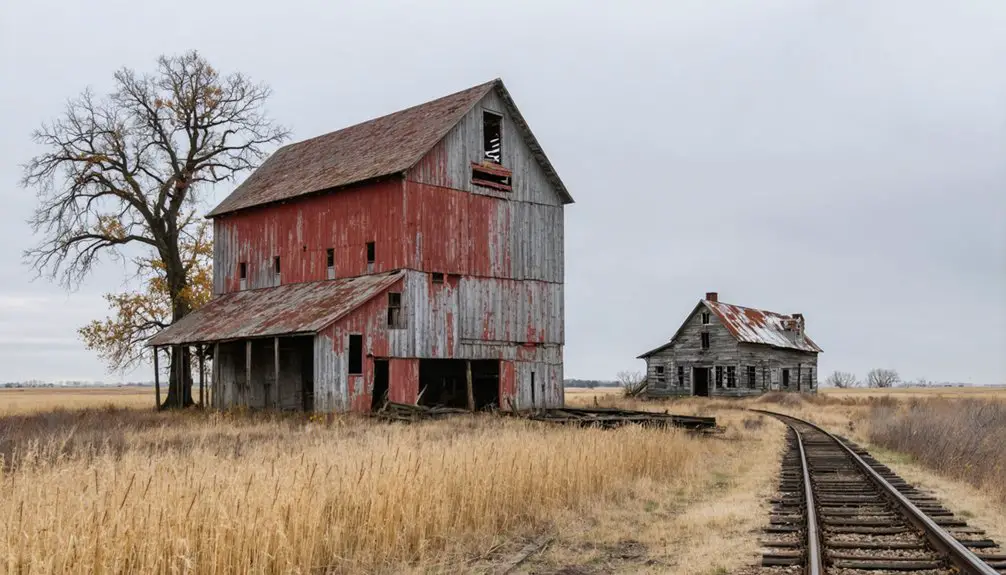You’ll find Winnipeg Junction in Clay County, Minnesota, where it thrived as a railroad town from 1887 to 1909. At its peak, this Northern Pacific Railroad hub supported 260 residents with three stores, two hotels, and multiple saloons across three city blocks. When the railway rerouted its mainline one mile north to Manitoba Junction in 1906-1909, the town quickly emptied. Recent archaeological discoveries at the abandoned townsite reveal fascinating details about frontier life and immigrant culture.
Key Takeaways
- Winnipeg Junction was established in 1887 as a railroad town in Clay County, Minnesota, reaching a peak population of 260 residents.
- The town flourished with three stores, two hotels, multiple saloons, and essential services centered around the Northern Pacific Railroad.
- Between 1906-1909, Northern Pacific rerouted its mainline north, leading to the town’s rapid abandonment and transformation into a ghost town.
- Recent archaeological excavations revealed artifacts from Ole Gol’s Saloon, providing insights into immigrant life and saloon culture.
- The abandoned town site remains as a historical reminder of how railway-dependent communities could quickly rise and fall.
The Birth of a Railroad Town (1887)
The establishment of Winnipeg Junction in 1887 marked a pivotal moment in Clay County, Minnesota’s railroad expansion. You’ll find this historic settlement nestled in section 22 of Highland Grove Township, where the Northern Pacific Railroad strategically positioned a significant junction point along its ambitious transcontinental route.
As the Northern Pacific extended its reach westward, connecting the Great Lakes to the Pacific Coast, you’d have witnessed the birth of a quintessential railroad town. Winnipeg Junction emerged purely from the railroad’s presence, symbolizing the freedom of movement and commerce that rail transport promised. With the railroad’s main line completed in 1883, the foundation was set for Winnipeg Junction’s development just four years later.
The town’s strategic location along the Northern Pacific’s expanding network made it an essential hub for both the railroad’s operations and the region’s growing transportation infrastructure. Within two decades, the settlement flourished into a bustling community with three busy saloons serving the local population.
Peak Years and Community Life
During Winnipeg Junction’s heyday, you’d find a thriving community of 260 residents supported by three stores, two hotels, and multiple saloons in the three-block town plat.
The town’s business district served both railway passengers and local farming families, with essential services including a grain elevator, bakery, three livery stables, and a post office. Like many towns named after geographic distinctions such as Clay County, which exists in multiple U.S. states, Winnipeg Junction’s name reflected its important railway location. Recent archaeological findings from Minnesota State University Moorhead have provided valuable insights into the daily lives of past residents.
You could witness the social fabric of daily life unfolding at gathering spots like Ole Gol’s saloon and Teddy Johnson’s restaurant, where residents would congregate after work or between train arrivals.
Bustling Railroad Hub Life
As railroad activity surged through Minnesota’s northern corridors in the late 1800s, Winnipeg Junction emerged as an essential hub supporting approximately 260 residents at its peak.
You’d find a bustling railroad culture centered around three city blocks, where workers and their families created a tight-knit community between shifts. A Northern Pacific Railway spur line to Winnipeg established the town’s importance in 1886.
The town’s community dynamics revolved around local hotspots like Ole Gol’s saloon, three stores, and two hotels. You could grab a meal at one of two restaurants, pick up mail at the post office, or gather with neighbors at the church.
While workers managed the challenging rail operations near the Buffalo River, their families kept the town’s heart beating through the school, bakery, and livery stables.
This crucial junction moved iron ore and freight through Minnesota’s expanding rail network. Much like Duluth’s role as the largest inland port, Winnipeg Junction played a vital part in the region’s transportation infrastructure.
Commerce and Local Business
Commerce flourished across Winnipeg Junction’s three city blocks, where local businesses served both railroad workers and resident families.
The town’s local trade ecosystem featured diverse establishments, from essential services to entertainment venues. You’d find everything needed for daily life, including fresh bread from the bakery and supplies from three general stores. The area’s Scandinavian immigrants formed the majority of the population, shaping the local business culture.
Business diversity thrived through strategic positioning along rail routes. The Northern Pacific Railroad brought prosperity and development to the area.
- Three saloons, including Ole Gol’s popular establishment, offered gathering spaces
- Two hotels provided lodging for travelers and railroad workers
- Three livery stables supported transportation needs
- A grain elevator facilitated agricultural commerce
- The post office connected residents to the wider world from 1887-1910
All this activity centered around the railroad’s presence until its fateful relocation in 1909.
Social Gathering Spaces
While Winnipeg Junction’s physical footprint spanned just three city blocks, its social fabric wove together through a rich network of gathering spaces that defined daily life in the late 1800s.
You’d find the heart of social dynamics centered around three bustling saloons, two restaurants, and a pair of hotels that served both locals and railway travelers. Ole Gol’s Saloon doubled as a dining establishment, creating a versatile space for communal gatherings.
The church and school anchored family life, while three livery stables became impromptu meeting spots where townsfolk exchanged news.
During train arrivals and departures, you’d witness the town spring to life as workers, travelers, and residents converged near the station, creating a vibrant atmosphere that pulsed with the rhythm of the railroad.
Railroad Operations and Economic Impact
You’ll find Winnipeg Junction‘s railroad development was strategically positioned at a crucial crossing point where the Northern Pacific’s spur line met their main east-west route in 1886.
The junction’s placement supported significant cargo and passenger traffic, connecting Minnesota’s resource-rich regions to major distribution points and enabling cross-border trade with Canada.
Rail Junction Strategic Placement
When Northern Pacific Railroad established Winnipeg Junction in 1887, they strategically positioned it at a critical fork where their main east-west line intersected with a northbound spur route to Winnipeg. This railway infrastructure decision transformed the landscape, though challenging terrain would later prove problematic for operations.
You’ll find the junction’s placement reflected the rapid transportation evolution of the era, connecting major rail corridors to Canadian markets.
- Located just two miles west of Hawley for ideal regional connectivity
- Positioned at a natural branching point for efficient train routing
- Built on former Lake Agassiz bed, creating foundation challenges
- Situated near Buffalo River, impacting ground stability
- Designed as competitive hub between Northern Pacific and Lake Superior & Puget Sound railroads
Cargo and Passenger Traffic
Northern Pacific Railroad’s operations at Winnipeg Junction thrived between 1887-1908, handling substantial agricultural cargo from the Red River Valley and lumber shipments from northern Minnesota’s forests.
The cargo dynamics centered on bulk commodities, supported by grain elevators and storage facilities, though track instability from the Lake Agassiz basin often hampered efficient transport.
You’d have found robust passenger trends during this period, with the junction’s 260 residents supported by railroad-dependent services.
Hotels, restaurants, and saloons catered to travelers moving between regional hubs like Duluth, St. Paul, and Canada.
Competition between Northern Pacific and Lake Superior & Puget Sound railways initially boosted traffic volume, but operational challenges from track sinking and the Buffalo River’s soggy terrain ultimately led to the 1908 reroute, ending the junction’s prominence.
Economic Growth Through Railways
Although established in 1887, Winnipeg Junction’s economic importance truly emerged through its strategic position as a critical railway hub connecting Minnesota to Canada. The railroad history shaped this Clay County settlement into a bustling center of commerce, where you’d find a thriving community built on economic dependencies tied to rail transport.
- Northern Pacific Railroad’s investment spurred rapid development, pushing the population beyond 250 residents.
- Multiple businesses emerged to serve rail traffic – from grain elevators to hotels and saloons.
- The junction’s position facilitated trade between Minnesota’s iron ranges and international markets.
- Rail access drove land development, with new blocks platted near the tracks.
- Local employment opportunities attracted immigrants, creating a diverse workforce in rail operations.
Daily Life in the Frontier Settlement
Life in Winnipeg Junction revolved around the bustling railroad junction that gave the town its name and purpose.
As a resident, you’d find your daily routines centered on the rail-side community of wooden homes and boarding houses, where outhouses marked the edges of residential lots.
The town’s cultural practices reflected its frontier spirit, with three saloons serving as the primary social hubs where you could grab a meal or meet fellow townspeople.
You’d buy your necessities at small retail stores and bakeries, pick up mail at the post office, and perhaps attend services at the local church.
When you needed to travel, you’d rely on the railroad or visit the livery stables to rent a horse.
Children attended the local school, while community gatherings strengthened bonds among the 260 residents.
The Business District and Services

Commerce thrived along the three city blocks of Winnipeg Junction, where businesses lined the Northern Pacific Railroad spur to serve both residents and travelers. The business dynamics reflected a bustling frontier economy, with three general stores anchoring the service evolution of this railway town. Originally established as Hawley Junction in 1883, the town would soon become a vital commercial hub.
You’d find essential amenities supporting daily life, transportation, and social activities.
- Two hotels and restaurants catered to travelers while three saloons fostered community gatherings
- Three livery stables supported horse-based transportation needs before automobiles arrived
- The post office (1887-1910) connected residents to the wider world
- A grain elevator served local farmers’ storage and trading requirements
- Ole Gol’s Saloon and Restaurant left behind artifacts revealing turn-of-the-century business operations
When the railroad relocated in 1909, businesses quickly moved to nearby towns like Manitoba Junction and Lake Park.
Railway Rerouting and Town Decline
Between 1906 and 1909, the Northern Pacific Railway‘s decision to reroute its mainline one mile north of Winnipeg Junction would seal the town’s fate.
You’ll find the railway engineering behind this move was driven by serious challenges – steep hills and unstable, soggy ground near the Buffalo River that threatened safe operations.
The railroad established a new junction called Summit (later Manitoba Junction) along the rerouted line, effectively cutting off Winnipeg Junction’s essential rail access. The new line connected directly to Grand Forks, Dakota through more optimal terrain.
Without this critical town infrastructure, the community’s population of 260 quickly scattered to nearby rail-connected towns like Hawley, Lake Park, and Dale.
Today, the abandoned town site stands as a memorial to how railway-dependent communities lived and died by the tracks, preserving valuable archaeological evidence of turn-of-the-century life in the Upper Midwest.
Archaeological Discoveries and Research

Recent archaeological investigations at Winnipeg Junction have uncovered a wealth of artifacts from refuse pits behind Ole Gol’s Saloon and a nearby restaurant, dating to the late 19th and early 20th centuries.
Led by Dr. Amanda Butler and Minnesota State University Moorhead students, the excavation techniques revealed fascinating insights into immigrant lifestyles and saloon culture through artifact analysis and refuse patterns.
- Large quantities of bottle tops and glass fragments showcase the town’s vibrant drinking culture
- Women’s shoes and clothing items challenge traditional gender roles in saloon spaces
- A turn-of-the-century battery hints at early technological advancements
- GIS satellite imagery helps map historical context of building locations
- Preservation challenges in refuse pits and outhouses require careful excavation
The findings illuminate community interactions in this frontier railroad town, where three saloons served a population of just 250 residents.
Population Movement and Regional Impact
While Winnipeg Junction initially flourished as a strategic railroad settlement in 1887, its population of 250 residents dispersed rapidly after the Northern Pacific Railroad rerouted its tracks in 1908-1909.
You’ll find the population displacement created a ripple effect across Clay County, as residents physically moved their homes and belongings to neighboring communities. This regional migration primarily benefited towns like Manitoba Junction, Dale, Hawley, and Lake Park, which absorbed the displaced families and businesses.
The town of Dale, in particular, emerged as a direct offshoot from Winnipeg Junction’s abandonment. Within just 14 years of the town’s founding, this mass exodus transformed the region’s demographic landscape.
Legacy of a Lost Settlement

Today, archaeological discoveries at Winnipeg Junction offer remarkable insights into late 19th-century frontier life in Clay County, Minnesota. The town’s cultural significance extends beyond its brief 20-year existence, preserving vital historical evidence of railroad-era settlements.
You’ll find a wealth of artifacts that tell the story of daily life, from saloon activities to early electrical innovations.
- Excavated refuse pits reveal diverse social spaces, challenging assumptions about gender roles in frontier establishments.
- GIS mapping techniques have documented the precise layout of this railroad town’s three city blocks.
- Archaeological findings showcase early electrical technology through recovered battery components.
- The site demonstrates how railroad decisions shaped the rise and fall of Midwest settlements.
- Historical preservation efforts continue to uncover new details about Clay County’s railroad heritage.
Frequently Asked Questions
What Was the Average House Price in Winnipeg Junction During Its Peak?
Like a pioneer’s dream on the frontier, you’d have found average house prices between $300-$700 during the historical peak years of 1886-1900, with costs varying by lot location and build quality.
Were There Any Major Crimes or Notable Lawmen in Winnipeg Junction?
You won’t find records of major crimes or notable lawmen in this area’s history. The town’s crime history was unremarkable, and law enforcement likely consisted of basic county-level oversight.
What Happened to the Buildings After the Town Was Abandoned?
Like migrating birds, most buildings didn’t stay to crumble. You’d find they were dismantled and moved to nearby towns like Hawley, Lake Park, and Dale, leaving only scattered remains for local wildlife.
Did Any Famous People Ever Visit or Live in Winnipeg Junction?
You won’t find any famous visitors in Winnipeg Junction’s historical records. The town’s brief existence and industrial nature focused on railroad operations rather than attracting notable personalities or cultural significance.
How Did Severe Weather Events Affect the Town’s Development and Operations?
When your train got stuck in 1908’s muddy tracks, you’d understand how harsh weather patterns crippled daily operations. Buffalo River flooding and soil instability created economic impacts that forced railroad rerouting.
References
- https://kids.kiddle.co/Winnipeg_Junction
- https://en.wikipedia.org/wiki/Winnipeg_Junction
- https://www.wikiwand.com/en/articles/Winnipeg_Junction
- https://www.thefmextra.com/winnipeg-junction-revisited/
- https://www.youtube.com/watch?v=upsu4KmzhO4
- https://en.wikipedia.org/wiki/Northern_Pacific_Railway
- https://www.ndstudies.gov/gr4/early-settlement-north-dakota/part-1-early-settlement-north-dakota/section-9-railroads
- https://en.wikipedia.org/wiki/Clay_County
- https://www.winnipegjunction-education-project.com
- https://www.dot.state.mn.us/culturalresources/docs/rail/sectione.pdf



